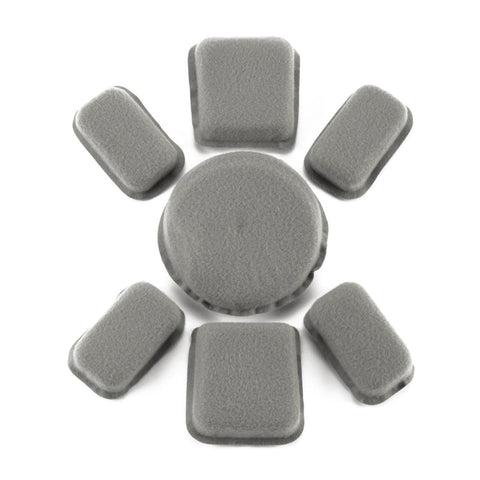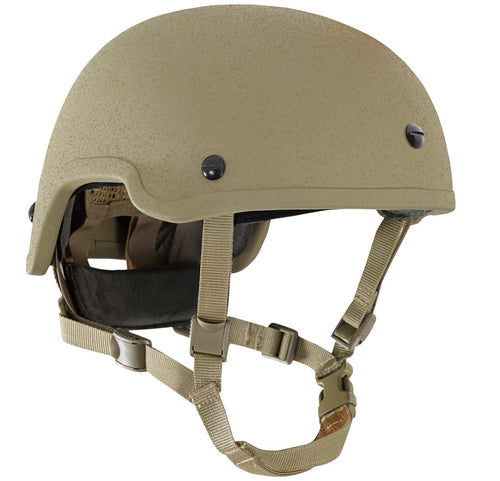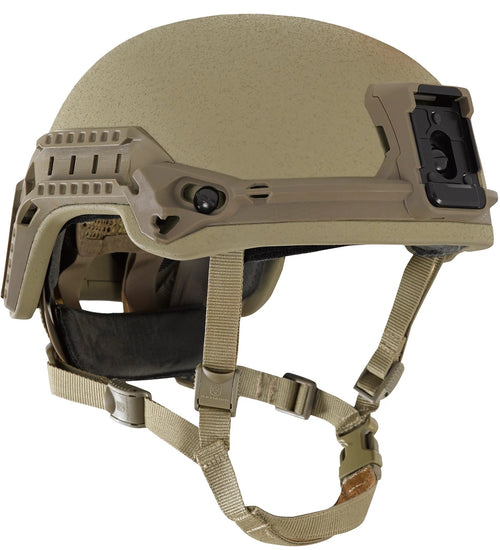Galvion is a leader is military helmets offering ballistic and blunt force protection in combat environments. There is two helmet systems they offer; the Caiman and the Viper series. In this article, we'll break down the characteristics of each helmet to help you better determine which style of headset would work best for you.
- Ballistic vs Non-Ballistic
- Liner
- Cut
- Configurations
- Physical Characteristics (Weight, Thickness, and Threat/Blunt Protection)
Ballistic vs Non-Ballistic
Ballistic helmets offer protection against both gunfire and blunt impacts while non-ballistic or bump helmets offer protection just against blunt impacts such as falling debris.
Non-ballistic helmets are used in non-combat environments such as climbing, in armored vehicles, or situations where you might “bump” your head. Non-ballistic helmets are lighter and don’t offer protection against gunshots and are often less expensive than ballistic helmets due to their components.
The Galvion Caiman headset comes in ballistic, bump, and hybrid. Hybrid helmets are bump carbon composite helmets that can be modified later to be ballistic using the Caiman Hybrid Ballistic Applique.
The Galvion Viper series headsets are A3, A5, and P2 and are only ballistic. We’ll talk about the differences between these headsets later on.
The first step in determining which Galvion headset you’ll need is to start with your application. If you need protection against gunfire, you’ll need a ballistic helmet but if you just need protection from non-gunfire impacts, you can use a bump or hybrid helmet.
|
Helmet |
Protection Level |
|
Caiman Bump |
Non-Ballistic |
|
Caiman Hybrid |
Non-Ballistic (Optional Ballistic Attachment) |
|
Caiman Ballistic |
Ballistic |
|
Viper A5 |
Ballistic |
|
Viper P2 |
Ballistic |
|
Viper A4 |
Ballistic |
Liner
The purpose of helmet liners is to provide a padded layer inside the helmet’s shell to provide comfort, breathability, and impact protection. Oftentimes helmets are worn for long hours so a main concern for soldiers is comfort.
Galvion helmets have three liner systems. The APEX Liner, which is only available on the Caiman series, the advanced 7-pad liner which is only available in the Viper A5 and the Modular Suspension System (MSS liner), which is only available on the Viper series. P2 and A3.
The Caiman APEX Liner is the most advanced liner which lets you customize by removing and repositioning the pads to make it more comfortable and fitting for you. This liner also offers a more stable fit and alleviates heat buildup.

The Modular Suspension System (MSS) and 7-Pad Liner both hold their shape over time and offer breathability. The 7-pad liner has 7 pads around the entirety of the interior helmet shell giving you more comfort.
The MSS liner has liners that go around the base of the interior helmet shell with an impact liner on the top of your head.
7-Pad Liner

MSS Liner

|
Helmet |
Liner |
|
Caiman (Hybrid, Bump, Ballistic) |
APEX Liner |
|
Viper A5 |
7-Pad Liner (Optional MSS Liner) |
|
Viper P2 |
MSS Liner |
|
Viper A3 |
MSS Liner |
Cut
Helmets typically are designed to be high cut and full cut. High cut helmets are cut higher around the ears so there’s space to use comms headsets such as the Comtac and Ops Core AMP. It provides more movability but less protection.
Full cut helmets come down further over the ear which aren’t compatible with comms headsets. Full cut helmets have better protection compared to high cut but are slightly heavier.
|
Helmet |
Cut |
|
Caiman (Hybrid, Bump, Ballistic) |
High |
|
Viper A5 |
High and Full |
|
Viper P2 |
High and Full |
|
Viper A4 |
High and Full |
Configurations
Galvion offers three configurations for their helmets, one hole drilled, mission-ready, and mission-ready plus.
One hole drilled is the basic of the helmet styles with one drilled hole for the front mount & side rails (not included) but can be added on later.

Mission ready is the next level up which includes the front mount and interlocking long rails to attach a headset and night vision goggles (NVG’s) too.

Lastly, Mission Ready Plus is the most advanced of the three which includes the front mount, interlocking long rails, and external Velcro.

Both the mission ready and mission ready plus integrate with face shields, visors, NVG, masks, and comms. The only diference between the mission ready and mission ready plus is the mission ready plus has the external velcro.
Difference Between Viper A5, P2, A3, & Caiman
The difference between all Galvion helmets is the physical characteristics such as weight, and thickness and the level of blunt/threat protection.
Weight
The weight of a helmet should be a large consideration in military helmets. Ballistic helmets are heavier than non-ballistic helmets due to the thickness of the shell. When helmets are worn all day, oftentimes a heavier helmet can make the wearer experience neck pain, fatigue, and mobility issues.
Helmets are used today for more than just ballistic protection. They’re used with night vision goggles, gas masks, communication headsets, and more. When you add more accessories to your helmet the heavier the helmet will become. Using a lighter helmet system from the start will help alleviate the general weight.
The Caiman Ballistic helmet has the lightest average weight compared to all three of the Viper Helmets.
Thickness
The thicker construction and materials of ballistic helmets will make them heavier and bulkier. Galvion headset systems do vary in thickness with the Caiman being the thinnest. There have been many improvements made to ballistic helmets to make them less thick for better stability on the wearer’s head.
Threat
Galvion ballistic helmets are tested by the National Institute of Justice NIJ Standard 0106.01 and NIJ 0101.06 IIIA Threats. This means they protect against handgun threats. It ideally means that a helmet is tested to stop the following handgun threats up to a certain velocity.
Caiman Ballistic
- Thickness: 0.24 in (6 mm)
- Weight AVG: 2.55 lbs.
- Threat: Pass .357 SIG, .44 Mag SJHP, 9mm, .44 MAG SWCGC
- Tested to stop .357 SIG and .44 Magnum Ammunition fired from longer barrel handguns. No rifle ammunition protection.
Caiman Bump
- Thickness: 0.08 in
- Weight Avg: 1.8 lbs.
- Blunt Impact: < 150G in all locations for 10 ft impact
Caiman Hybrid
- Thickness: 0.08 in
- Weight Avg: 1.62 lbs.
- Blunt impact: <150G in all locations for 10 ft impact
Viper P2 High Cut
- Thickness: 0.34 in
- Weight Avg: 2.91 lbs
- Threat: Pass
- .357 SIG, .44 MAG SJHP, 9mm, .44 MAG SWCGC
- Tested to stop .357 SIG and .44 Magnum Ammunition fired from longer barrel handguns. No rifle ammunition protection.
Viper A3 High Cut
- Thickness: 0.34 in
- Weight Avg: 3.25 lbs
- Threat:
- 9 mm
- .44 MAG SWCGC
Viper A5 High Cut
- Thickness: 0.35 in
- Weight Avg: 3.49 lbs for MSS and 3.34 lbs for 7-Pad
- Threat: Pass
- .357 SIG
- .44 MAG SJHP
- 9mm
- .44 MAG SWCGC

How First Source Wireless Can Help
Here at First Source Wireless, we're determined to help the U.S. Military and Law Enforcement find reliable head protection. We are an authorized dealer of Galvion helmets. If you need help finding the right helmet that works best for you, reach out to our customer service team. We'd be happy to help.



